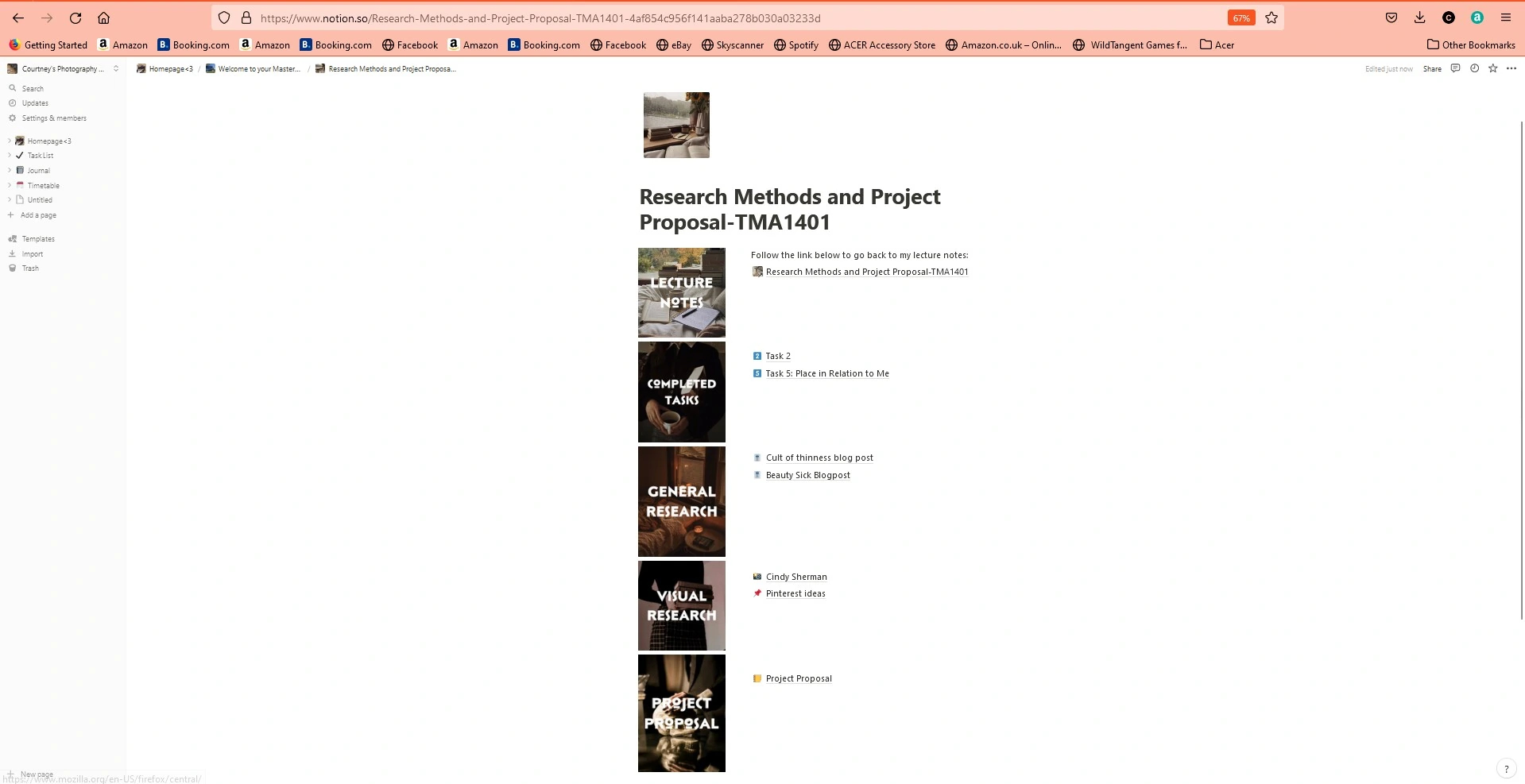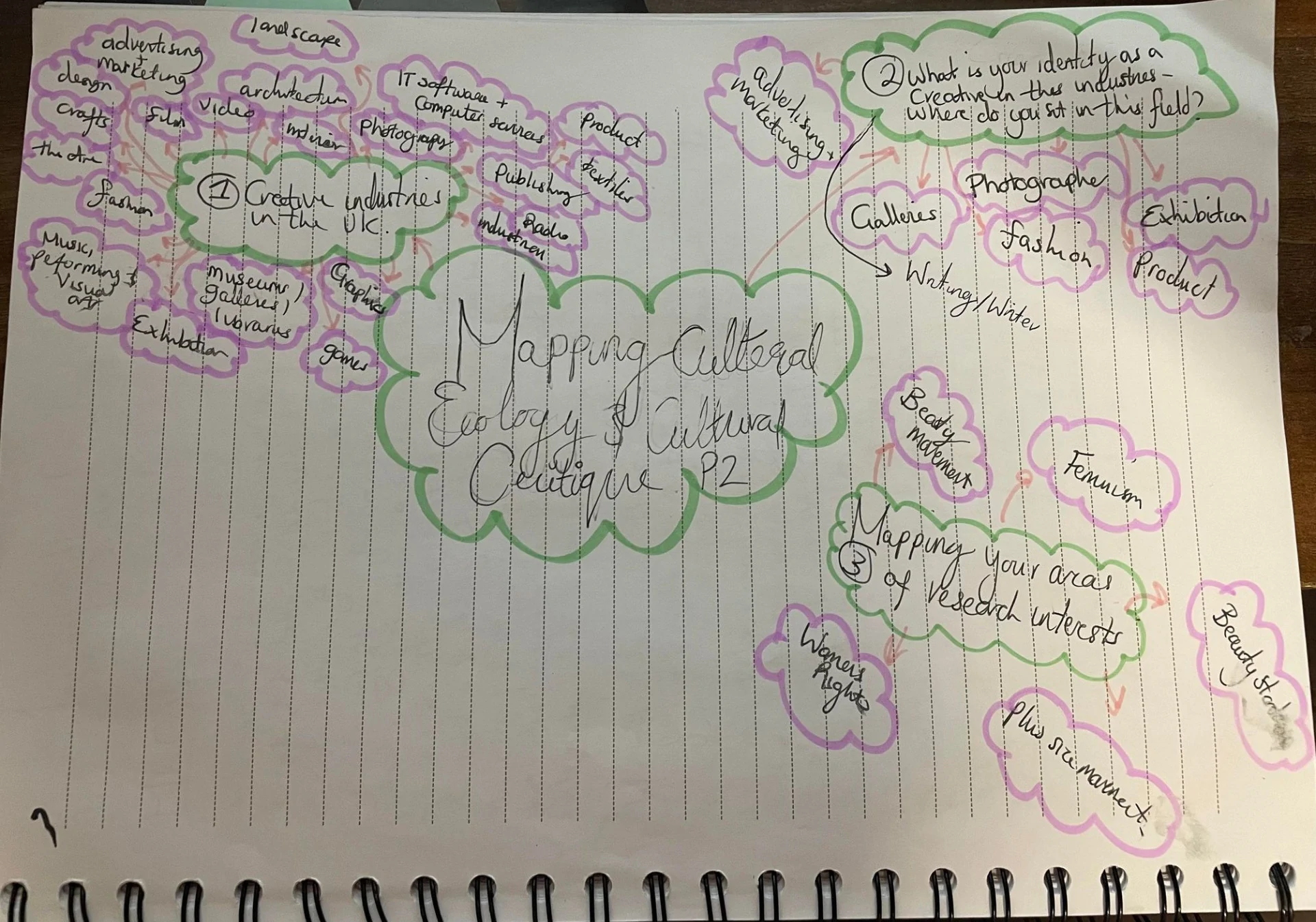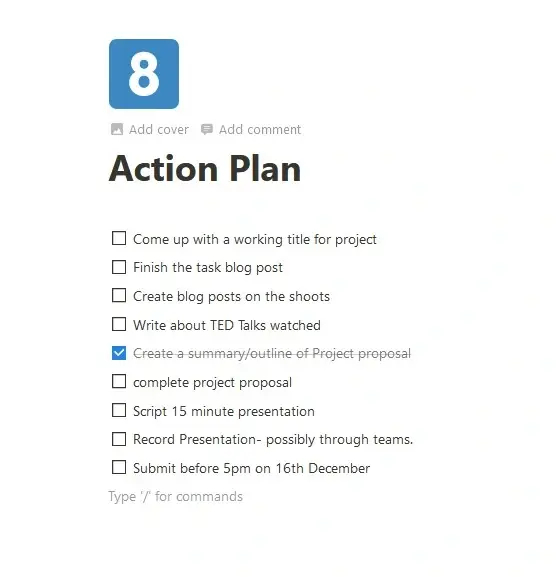TMA1401 Tasks

Welcome to my Task Blog post. Here you will find a all the tasks done for TMA1401 Research Methods and Project Proposal!
Task 1- Create a research folder.
Lately ive been obsessed with the website Notion. On there you create "work spaces" and you can design it however you like. So armed with a list of commands and a love for aesthetically pleasing layouts, I made a folder that excited me to add to!

Task 2-Create 3 slides of your current practice and what you're interested in exploring for your major project.
At this point I didn't have a fully formed idea of what my major project will be, but through the weeks this took hold.
Task 3- Mapping Cultural Ecology
MACAO
MACAO used environing (the innate tools we have to create) to take old, abandoned, desolate buildings and create spaces for art discourse by turning them into galleries and places for creatives through a peaceful form of protest. By staging a sit in and cleaning up the spaces to allow artists to create and discuss work, they took a building that was going to be used for the capitalist agenda, and transformed it into a space that challenges the ideas on art that imply it's only valuable when it makes money.
We often feel like the only way we can be creative is if we excelled at it to the point we are financially successful. It's not enough to just enjoy the activity, you must be good, then you must be able to sell it. We see this a lot through the education system;
Firstly, art is not considered a 'core' subject, implying that it isn't essential to businesses or for being successful.
Secondly, if a student doesn't excel in a way that the school expects, they try to steer that pupil away from art, despite its proven benefits to well being, or if its a passion. Art needs practise just like any other subject.
When i chose my options in year 9,at 14 years old, my mum told me not to take dance , instead i had to take a 'real subject', but in the end, I didn't do better than a C anyway. So how do we measure the value of the arts? and how come when we do it always seems to be undervalued?
Task 4- Mapping Cultural Industries

Task 5-Visualise your own relation to place
What is place to me? Place is completely subjective to each and every one of us. What makes place, is different for each person as we all bring our own experiences and contexts, essentially baggage, into a place that effects it. Some places with historical context have a place that outlives its inhabitants yet when we visit we still influence the meaning of that place and take away our own experience for it.
If we look at the direct definition of place we see 'a particular position, point or area in space: a location'.
However we often apply temporal attributes to place with phrases like ' I'm in a different place in my life right now' or ' we are not in the same place in our lives'.
As a photographer, it is my job to create place in my work. I craft the context I want and bend place to fit within it. Location of shoots are incredibly important to creating context within my images. I need to space i shoot in to be a reflection of what I'm trying to say and echo my concept so that the viewer is affirmed in my message instead of confused.
Task 6- Build a Reading List
Task 7- 5 Quotes from Chosen Texts
1. "But current beauty and fashion trends that advocate attaining ultra-thinness at any price are unrealistic. Given that most women's bodies do not naturally fit the thin ideal, these trends are destructive to women's health, self-esteem, and economic and social advancement within society."- Am I Thin Enough Yet? The Cult of Thinness and the Commercialization of Identity by Sharlene Hesse-Biber.
2. "The more legal and material hindrances women have broken through, the more strictly and heavily and cruelly images of female beauty have come to weigh upon us."- The Beauty Myth by Naomi Wolf.
3. "We have created a culture that tells women the most important thing they can be is beautiful. Then we pummel them with a standard of beauty they will never meet." - Beauty Sick by Renee Engeln, PhD
4. "Trying to convince myself i am allowed to take up space is like writing with my left hand when i was born to use my right -the idea if shrinking is hereditary"- poem frommilk and honey by Rupi Kaur.
5. "The increase in both 'eating disorders' and cosmetic surgery among women in western societies suggests, for most feminist commentators, the continuing constraints of the heterosexual economy. For some, it is evidence that, as women gain more civil status,particularly in the workforce, cultural forces acting in the interests of masculinity will seek to cut them down to size again. Both an obsession with slenderness and cosmetic surgery (itself, often used to change body size) are, arguably, are determined in one way or another by ideas of what men desire." Feminist Perspectives on the Body by Barbara Brook.
Task 8- Revisit the Project Proposal and Come up with an action plan.

Task 9 - Working with Examples
Part i
The research folio I decided to look at was one by fellow photographer Dr Yan Wang Preston. I had the privilege of being taught by Dr Preston during my BA and so the intrigue into Her work is not a new one.
The folio I chose from Dr Preston was entitled 'Forest'. The project, based in two different Chinese cities, is an investigation into nature restoration projects, encompassing the complexities and politics, through visual storytelling.
The question Dr Preston explored at was "what is the nature of nature in contemporary Chinese cities?" the aim was to explore this question both photographically and through experiences to develop a" visual narrative... far exploring the complexity, rather than the negativity, of constructed urban nature and the condition of the urban home."
The methods used by Dr Preston included critical observation and photographing city landscapes in China across a period of time. According to the folio "repeat photography is a powerful tool to eliminate the photographers prejudice." this statement implies that photographers go into a project with a set of expectations and ideas but through the process of repetition photography- which means using repeating shapes or patterns within a frame as part of its composition- you begin to approach a subject more objectively, your mind shuts out the part that is opinion based. The plan for the project originally was an emotional response to certain elements within the landscape. I think it's interesting how this aim changed to one more objective.
The contextual research was carried out first hand and included a wide range of different methods from conversations with city dwellers, tree transplanters, local journalists and environmentalists, to news reports and government websites, gaining perspective on national policy and public reception.
The layout of the document is just as important as the work it contains. It needs to be clear, concise and straight to the point. Without this people will quickly lose focus. It also needs to be visually stimulated. People like bright colours and pictures to capture their attention. As this is a research folio By a photographer, naturally photos are included. As previously stated, Dr Preston used repetition photography. You might think that this means the images throughout the series become too repetitive and dull, however, Dr Preston approaches the landscapes slightly differently so they each picture provides new insight into the topic. Dr Preston also uses the coloured green throughout the project. green is a colour we naturally associate with nature and so is a clever way to keep the audience interested as well as relating it back to the topic of the folio.
I also think the title, 'Forest' is an interesting choice as this project explores creating more green cities an urban nature through the routing and displacement of trees. It makes us question if forests are natural or if they can be made through the manipulation of nature.
The output of the research project was a scholarly book, original artistic works, creative body of inquiry, solo exhibition, contribution to collaboration group exhibitions, journal articles and conference contribution. All in all, the research was a rather successful project, addressing the complexities of the displacement of trees in relation to the public and politics.
Part ii
-Foxlow photography
Body positivity is all about feeling confident in your own skin. When I was thinking about confident poses for my model to do, I naturally thought of boudioresque style photos. The poses are designed, especially nowadays, to empower the women performing them, to make them feel confident and sexy. It is different from the ideas of societal beauty standards as it makes your feel desired no matter your body type, where as the impossible idea of beauty seems like it is there to remind you you are not enough or you are too much. Foxlow photography is based in Derbyshire, England, but I will be more focused on their advertisement on the popular app Tiktok. It is an account I have followed for a few months out of general interest and the face of the brand is a plus size photographer. I have definitely have found inspiration, not just on how to pose within the studio, but also tips on how to keep my models comfortable during these shoots- even if my models are fully clothed.
The poses that the women do are designed to accentuate their natural curves rather than hide them or manipulate them, through things like the arching of the back. In fact, the studio even boasts that you can be 50+ and they wouldn't even dream of hiding your figure! The company on a whole is very body positive and is more than happy to show their clients of all shapes and sizes. The woman who runs the TikTok, Danielle, has the aim to help women feel better in their skin.
- Rochelle Fatleopard
Rochelle advertises herself as a Body Inclusive Photography. One of her ongoing projects, started in 2017, is 'Friends on Polaroid.' Here Rochelle photographs her friends and models at their most vulnerable states of being, based on whatever that meant to them. A lot of the images include nudity, with the odd clothed one as an exception. We heavily associate being naked with vulnerability as without clothes, their is nothing left to hide behind. The body is on full display including things our current body standards have us believing are flaws.
Her models appear to be mainly women of colour, another minority whose diversity is finally growing thanks to wonderful activists. Looking through her images, it appears as if she doesnt edit much or airbrush, keeping the models natural. Photos of spots, stretchmarks, body rolls, freckles, cellulite, are all left for the viewer to see These are all things women are not supposed to possess. At least not according to the male gaze, where women are objectified as sexual objects of pleasure for the male viewers. the male gaze is heavily tied into body ideals.
What I really like about Rochelle's work is that even her editorials for big brands, like the one she did for converse, include a range of body types. The more big brands get behind body inclusivity, the more representation we see of different body types and the more women will find it easier to feel beautiful in their own skin.
- Andrew Thomas Clifton
Clifton is a multifaceted photographer, His website boasts of a range of skills including Boudior photography, portrait photography, fashion and editorial, food and drink, and more. One of the main features of his photography is the body positive aspects.
Clifton is a self taught photographer, experimenting sonce 2005 and his job as a photographer is to "interpret and love the nature and relativity of beauty across the universe and to share that viewpoint with the viewer" (Clifton, N.D) One of the key words from this statement is 'relativity'. Most of the time we feel like beauty is being presented as an objective truth, rather than something that can be subjective. Sure, things like sunsets are universally accepted as beautiful, but when it comes to people, I think beauty is far more complex. Relativity is sed a lot, especially in ethical discussions, to describe something that cannot be applied universally to a specific set of standards. So I think what Clifton is saying here is that beauty cannot be defined by a set of rules on physical features and it is his job to present different versions of it.
Task 10- Aims and Objectives
- To Explore the Link between Eating Disorders and body standards.
- To create a response to constrictive body standards placed on women through a series of photo shoots portraying body positivity on a range of different bodies.
- To create a book that combines writings and images.
- To Collab with the writing society to include experiences from other people regarding the body- in the form of poems or short stories.
Reference List
- Brockington, R. (n.d). Rochelle FatLeopard. https://www.rochellefatleopard.com/
- Brook, B. (1999). Feminist Presepctives on the Body. Pearson Education Limited.
- Clifton, A.T. (n.d). Andrew Thomas Clifton . https://andrewthomasclifton.com/
Engeln, R. (2017). Beauty Sick. HarperCollins Publishers.
- Foxlow Photography. (n.d). foxlowboudoir . TikTok. https://www.tiktok.com/@foxlowboudoir
Hesse-Biber, S. (1996). Am I Thin Enough Yet?. Oxford University Press Inc.
- Kaur R. (2015) milk and honey. Andrews McMeel Publishing
- Preston, Y.W. (2018). Forest. University of Huddersfield. https://research.hud.ac.uk/media/assets/document/research/ceada/YanPreston-Forest-web.pdf
- Wolf,N. (1991) The Beauty Myth. Vintage Books